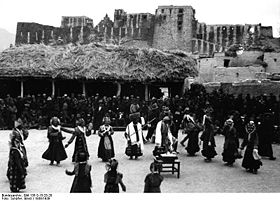Ache Lhamo
- Ache Lhamo
-
|
|

Représentation d’Aché Lhamo devant le dzong de Gongkar, 1939
|
| Pays * |
|
| Région * |
Asie et Pacifique |
| Liste |
Liste représentative |
| Fiche |
00208 |
| Année d’inscription |
2009 |
|
* Descriptif officiel UNESCO |
modifier  |
L'opéra tibétain, théâtre tibétain, Akyi Lhamu, Lhamu, Namte[1], Lhamo ou Aché Lhamo, qui signifie littéralement « Sœur-déesse », est un opéra populaire tibétain. Il s’agit d’une combinaison de danses, de chants et de chansons. Le répertoire provient de l’historiographie bouddhiste et tibétaine. « L'opéra tibétain » a été inscrit en 2009 par l'Unesco sur la liste représentative du patrimoine culturel immatériel de l'humanité[2].
Histoire
L'opéra tibétain a été fondé au XIVe siècle par Thang Tong Gyalpo, un Lama et un constructeur de pont. Gyalpo et sept filles recrutées ont organisé la première représentation pour lever des fonds pour construire des ponts pour faciliter le transport au Tibet. La tradition a perduré, et le Lhamo se joue à diverses occasions festives comme le festival de Linka et de Shoton.
L'institut tibétain des arts de la scène de Dharamsala, mène une compagnie d'opéra, qui produit des spectacles dans le but de promouvoir cette forme d'art.
Artistes connus
Notes et références
Liens externes
Sur les autres projets Wikimedia :
Wikimedia Foundation.
2010.
Contenu soumis à la licence CC-BY-SA. Source : Article Ache Lhamo de Wikipédia en français (auteurs)
Regardez d'autres dictionnaires:
Lhamo — Lhamo, or Ache Lhamo, which literally means sister goddess , is a Tibetan folk opera. It is a combination of dances, chants and songs. The repertoire is drawn from Buddhist stories and Tibetan history.The Tibetan opera was founded in the 14th… … Wikipedia
Namgyal Lhamo — Background information Also known as The Nightingale of Tibet Born 1956 … Wikipedia
Namgyal Lhamo — Demande de traduction Namgyal Lhamo → Namgyal … Wikipédia en Français
Tibetische Musik — Straßenmusiker mit dreisaitigem Zupfinstrument damiyan Tibetische Musik ist die in der Tradition der Religion und Alltagskultur Tibets stehende Musik, so wie sie von Tibetern im Autonomen Gebiet Tibet, den angrenzenden Nachbarländern Nepal,… … Deutsch Wikipedia
Tibetan culture — Tibetan Monk churning butter tea Tibetan culture developed under the influence of a number of factors. Contact with neighboring countries and cultures including Nepal, India and China have influenced the development of Tibetan culture, but the… … Wikipedia
Tenzin Gönpo — Tenzin Gönpo, Tibet d hier et d aujourd hui, musée Guimet, mai 2010 … Wikipédia en Français
Tibetan people — བོད་པ། 藏族 Top: Milarepa • Thubten Gyatso • Buton Rinchen Drub • Ngapoi Ngawang Jigme • Gendun Drup Bottom … Wikipedia
Norbulingka — Not to be confused with Norbulingka Institute. Norbulingka Norbulingka Tibetan name … Wikipedia
Thang Tong Gyalpo — Thangtong Gyalpo Thangtong Gyalpo (Tibetan: ཐང་སྟོང་རྒྱལ་པོ་, Wylie: thang stong rgyal po) (1385–1464 or 1361–1485) also known as Drubthob Chakzampa (lcags zam pa) and Tsundru Zangpo (brtson grus bzang po) was a great Buddhist adept, a yogi … Wikipedia
Monastère de Derge Gonchen — Gongchen ou Gonchen (aussi appelé Dégé Gonchen, monastère de Dergé et Lhundup Teng) est un grand monastère Sakya bouddhisme tibétain dans la ville de Derge, dans le comté de Dergué au Sichuan, en Chine. Historiquement ce secteur était dans la… … Wikipédia en Français




